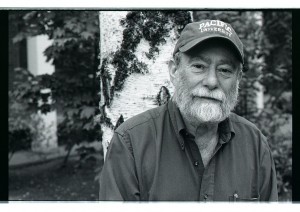“The Book of the Dead Man (The Northwest)”

Marvin Bell’s nineteenth book was the wartime collection, Mars Being Red (2007). His twentieth is 7 Poets, 4 Days, 1 Book, a collaboration of seven poets from five countries. Long a member of the Iowa Writers’ Workshop faculty, he teaches now for the brief-residency MFA program based in Oregon at Pacific University.
The first incarnation of Bell’s The Book of the Dead Man appeared in 1994 (Copper Canyon). A second volume, Ardor, was published in 1997. “About the Dead Man and the Northwest” is from a new, forthcoming collection of “Dead Man” poems. Look for more of Marvin Bell’s poems in Poetry Northwest in the months ahead.
◊
The Book of the Dead Man (The Northwest)
Live as if you were already dead.
Zen admonition
And the fish swim in the lake / and do not even own clothing.
Ezra Pound, “Salutation”
1. About the Dead Man and the Northwest
Picture the dead man in two rooms in the northwest corner of his being.
In the one, it is day, and in the other, night, and he lives in both.
His street dead ends at a cliff above a rattling of ropes clanging on masts and the whimper
of lazy tides.
There are lumps on the sea bottom.
There is also, as elsewhere, a worldly stomping that threatens the scale pan of justice.
The dead man fingers a lucky stone like Casanova his address book.
For the northwest, which may feel ashen to the displaced easterner under the white
of a winter sky, pleases him greatly.
It is the density of forest that overwhelms his language, as the dexterity of the tides
smooths his hours and the mountain passes frame the light at midday.
The dead man smells the faint fizz of froth at shore’s edge.
It is the smell of the soap the adolescent rinses away before a date.
It is the loamy feel in his throat when a young man is asked to speak.
The dead man has opened the map, and run his finger along the interstates, and driven
west to land’s edge.
The dead man’s distant friends look toward England, it is old.
The dead man is himself old but is forever newly at home.
He who grew up near the sunrise feels more at home near the sunset.
That’s the dead man’s duality, drawn east-to-west and south-to-north.
2. More About the Dead Man and the Northwest
Though we make a junkyard of the sea, still the fish wink.
The dead man’s turf is piled with lug nuts and vinyl, tubing and wire, razor blades,
batteries, bubble wrap and book bags–name anything.
Still the dead man toasts both the present and the absence to come.
Salmon that went against the current.
Madronas that peeled without a whimper, you seers take notice.
The dead man has a favorite heron because they see one another daily.
And the one sits in the other’s tree and squawks when it flies off or returns.
What makes one go here or there, and stay, may be the rhythm of the heart, or the firing
of brain cells or the feel of the air.
The dead man has heavy bones, he does not float.
He has small pores.
He cannot be smelled as quickly by the wolf, a trait that brought them face to face.
He walks by the elk and the deer who do not care.
Like them, he knows time by the look of the light and the smell.
The dead man, standing between the Pacific and Cascades, at the tip of the Quimper
Peninsula, is almost out of time.
The dead man is not as much about doing.
The dead man was, and will be, and, for now, just is.
◊
